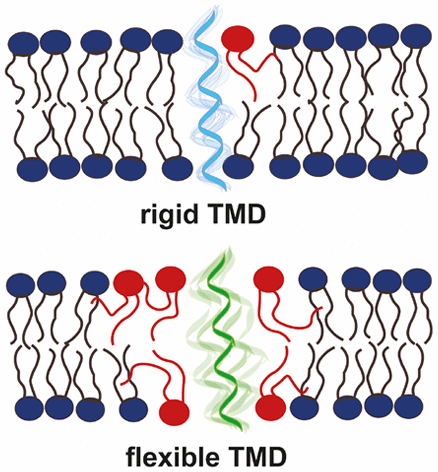当前位置:
X-MOL 学术
›
J. Phys. Chem. Lett.
›
论文详情
Our official English website, www.x-mol.net, welcomes your feedback! (Note: you will need to create a separate account there.)
Transmembrane Helix Induces Membrane Fusion through Lipid Binding and Splay
The Journal of Physical Chemistry Letters ( IF 5.7 ) Pub Date : 2018-05-25 00:00:00 , DOI: 10.1021/acs.jpclett.8b00859 Holger A. Scheidt 1 , Katja Kolocaj 2, 3 , Julie Veje Kristensen 2, 3 , Daniel Huster 1 , Dieter Langosch 2, 3
The Journal of Physical Chemistry Letters ( IF 5.7 ) Pub Date : 2018-05-25 00:00:00 , DOI: 10.1021/acs.jpclett.8b00859 Holger A. Scheidt 1 , Katja Kolocaj 2, 3 , Julie Veje Kristensen 2, 3 , Daniel Huster 1 , Dieter Langosch 2, 3
Affiliation

|
The fusion of biological membranes may require splayed lipids whose tails transiently visit the headgroup region of the bilayer, a scenario suggested by molecular dynamics simulations. Here, we examined the lipid splay hypothesis experimentally by relating liposome fusion and lipid splay induced by model transmembrane domains (TMDs). Our results reveal that a conformationally flexible transmembrane helix promotes outer leaflet mixing and lipid splay more strongly than a conformationally rigid one. The lipid dependence of basal as well as of TMD-driven lipid mixing and splay suggests that the cone-shaped phosphatidylethanolamine stimulates basal fusion via enhancing lipid splay and that the negatively charged phosphatidylserine inhibits fusion via electrostatic repulsion. Phosphatidylserine also strongly differentiates basal and helix-driven fusion, which is related to its preferred interaction with the conformationally more flexible transmembrane helix. Thus, the contribution of a transmembrane helix to membrane fusion appears to depend on lipid binding, which results in lipid splay.
中文翻译:

跨膜螺旋通过脂质结合和展开诱导膜融合
生物膜的融合可能需要张开的脂质,其尾部会短暂地到达双层的头基区域,这是分子动力学模拟提出的一种情况。在这里,我们通过关联脂质体融合和模型跨膜域(TMDs)诱导的脂质膨胀,实验性地检验了脂质膨胀的假说。我们的结果表明,构象柔性的跨膜螺旋比构象刚性的螺旋膜更能促进外部小叶的混合和脂质的散布。基础的脂质依赖性以及TMD驱动的脂质混合和散开表明锥形磷脂酰乙醇胺可通过增强脂质散开来刺激基础融合,而带负电荷的磷脂酰丝氨酸可通过静电排斥抑制融合。磷脂酰丝氨酸还可以强烈区分基础和螺旋驱动的融合,这与其在构象上更灵活的跨膜螺旋的优选相互作用有关。因此,跨膜螺旋对膜融合的贡献似乎取决于脂质结合,这导致脂质张开。
更新日期:2018-05-25
中文翻译:

跨膜螺旋通过脂质结合和展开诱导膜融合
生物膜的融合可能需要张开的脂质,其尾部会短暂地到达双层的头基区域,这是分子动力学模拟提出的一种情况。在这里,我们通过关联脂质体融合和模型跨膜域(TMDs)诱导的脂质膨胀,实验性地检验了脂质膨胀的假说。我们的结果表明,构象柔性的跨膜螺旋比构象刚性的螺旋膜更能促进外部小叶的混合和脂质的散布。基础的脂质依赖性以及TMD驱动的脂质混合和散开表明锥形磷脂酰乙醇胺可通过增强脂质散开来刺激基础融合,而带负电荷的磷脂酰丝氨酸可通过静电排斥抑制融合。磷脂酰丝氨酸还可以强烈区分基础和螺旋驱动的融合,这与其在构象上更灵活的跨膜螺旋的优选相互作用有关。因此,跨膜螺旋对膜融合的贡献似乎取决于脂质结合,这导致脂质张开。



























 京公网安备 11010802027423号
京公网安备 11010802027423号